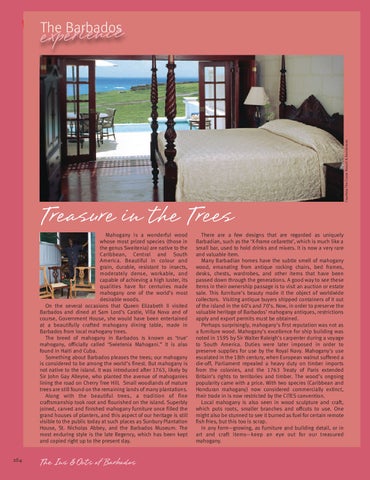experience
Treasure in the Trees Mahogany is a wonderful wood whose most prized species (those in the genus Sweitenia) are native to the Caribbean, Central and South America. Beautiful in colour and grain, durable, resistant to insects, moderately dense, workable, and capable of achieving a high luster, its qualities have for centuries made mahogany one of the world’s most desirable woods. On the several occasions that Queen Elizabeth II visited Barbados and dined at Sam Lord’s Castle, Villa Nova and of course, Government House, she would have been entertained at a beautifully crafted mahogany dining table, made in Barbados from local mahogany trees. The breed of mahogany in Barbados is known as ‘true’ mahogany, officially called ‘Swietenia Mahogani.” It is also found in Haiti and Cuba. Something about Barbados pleases the trees; our mahogany is considered to be among the world’s finest. But mahogany is not native to the island. It was introduced after 1763, likely by Sir John Gay Alleyne, who planted the avenue of mahoganies lining the road on Cherry Tree Hill. Small woodlands of mature trees are still found on the remaining lands of many plantations. Along with the beautiful trees, a tradition of fine craftsmanship took root and flourished on the island. Superbly joined, carved and finished mahogany furniture once filled the grand houses of planters, and this aspect of our heritage is still visible to the public today at such places as Sunbury Plantation House, St. Nicholas Abbey, and the Barbados Museum. The most enduring style is the late Regency, which has been kept and copied right up to the present day.
264
The Ins & Outs of Barbados
There are a few designs that are regarded as uniquely Barbadian, such as the ‘X-frame cellarette’, which is much like a small bar, used to hold drinks and mixers. It is now a very rare and valuable item. Many Barbadian homes have the subtle smell of mahogany wood, emanating from antique rocking chairs, bed frames, desks, chests, wardrobes, and other items that have been passed down through the generations. A good way to see these items in their ownership passage is to visit an auction or estate sale. This furniture’s beauty made it the object of worldwide collectors. Visiting antique buyers shipped containers of it out of the island in the 60’s and 70’s. Now, in order to preserve the valuable heritage of Barbados’ mahogany antiques, restrictions apply and export permits must be obtained. Perhaps surprisingly, mahogany’s first reputation was not as a furniture wood. Mahogany’s excellence for ship building was noted in 1595 by Sir Walter Raleigh’s carpenter during a voyage to South America. Duties were later imposed in order to preserve supplies for use by the Royal Navy. Mahogany's use escalated in the 18th century, when European walnut suffered a die-off, Parliament repealed a heavy duty on timber imports from the colonies, and the 1763 Treaty of Paris extended Britain’s rights to territories and timber. The wood’s ongoing popularity came with a price. With two species (Caribbean and Honduran mahogany) now considered commercially extinct, their trade in is now restricted by the CITES convention. Local mahogany is also seen in wood sculpture and craft, which puts roots, smaller branches and offcuts to use. One might also be stunned to see it burned as fuel for certain remote fish fries, but this too is scrap. In any form—growing, as furniture and building detail, or in art and craft items—keep an eye out for our treasured mahogany.
Courtesy The Crane Resort & Residences
The Barbados
